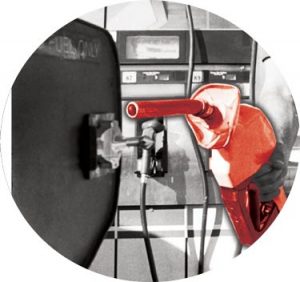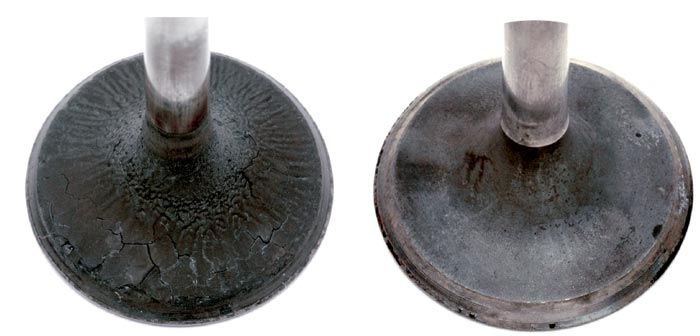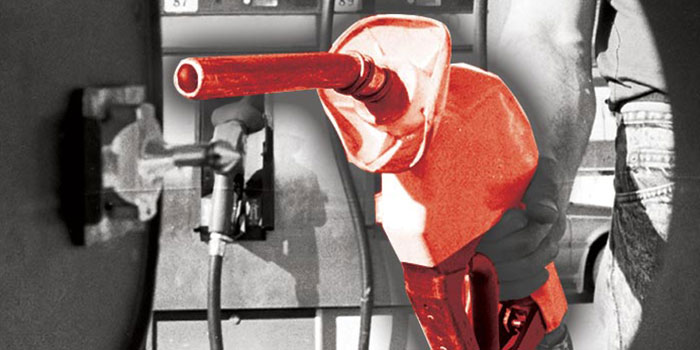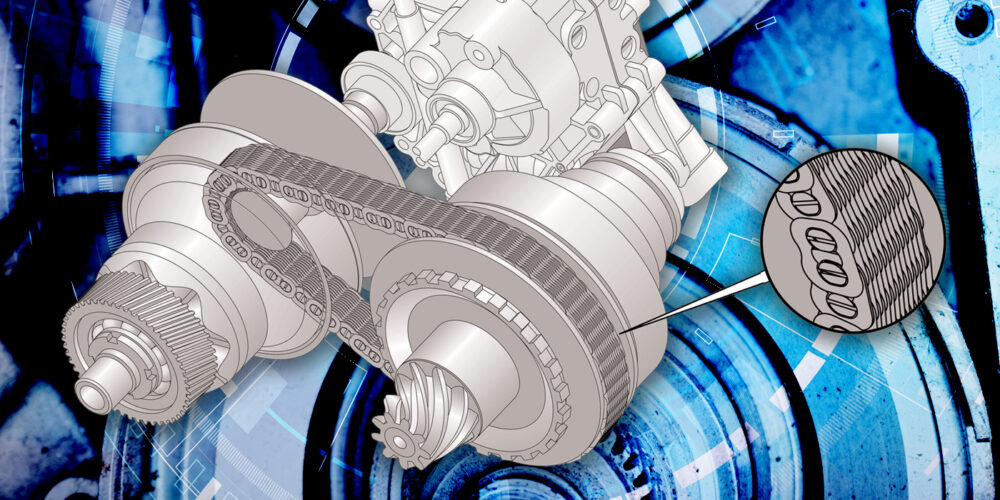 When deposit control additives are not adequate in gasoline, harmful deposits can build up inside the engine:
When deposit control additives are not adequate in gasoline, harmful deposits can build up inside the engine:
• Deposits that form in the throttle body can reduce airflow through the idle bypass circuit, thus affecting idle quality and smoothness. These deposits are formed by fuel vapors that rise up through the intake manifold.
• Deposits that form on the intake valves can restrict airflow through the intake ports, causing a loss of high-speed power. The deposits also can act like a sponge and momentarily soak up fuel spray from the injectors. This disrupts the mixing of air and fuel, causing a lean fuel condition, hesitation and reduced performance. Deposits also can cause valve sticking and valve burning. Intake valve deposits are formed by normal combustion byproducts, but may build up more rapidly if the valve guides or seals are worn and the engine is sucking oil down the guides.
A buildup of carbon deposits inside the combustion chamber also increases the risk of hot spots forming that may cause engine-damaging preignition. The hot spot ignites the fuel before the spark plug fires, causing a sharp rise in combustion pressure. Under extreme conditions (high rpm and load), preignition can burn a hole right through the top of a piston!
A condition known as Combustion Chamber Deposit Interference (CCDI) also can occur when the carbon deposits are so thick that the deposits on the piston and head make physical contact. This area, known as the squish area (piston to top of chamber), has a clearance that is about as thick as a paper clip. This can cause a loud metallic banging sound when a cold engine is first started. The deposits are soft and will gradually flake off. However, the flakes may lodge between the valves and seats causing a loss of compression, misfires and rough running when the engine is cold (a condition called Combustion Chamber Deposit Flaking, or CCDF).
Deposit Control
The formation of harmful deposits can be controlled by adding detergent-dispersants to gasoline, the most common of which is polybutene succinimide. Used with a petroleum carrier oil, detergent-dispersants help keep the intake manifold and ports clean. These chemicals are more effective than the carburetor detergents that were once used in gasoline, but they must be used at concentrations that are three to five times higher than that of the older carburetor detergents.

Deposit control additives such as polybutene amine (PBA) were introduced in 1970 to help keep injectors and intake valves clean. The only drawback with PBA is that too much of it can increase combustion chamber deposits. Polyetheramine (PEA), by comparison, cleans fuel injectors and valves, and does not increase combustion chamber deposits. In fact, it helps remove accumulated deposits inside the combustion chamber to reduce the risk of spark knock.
In 1995, the U.S. Environmental Protection Agency set minimum standards for additives in gasoline to prevent the formation of deposits in fuel injectors. Gasoline refiners had to certify that their additive packages met these standards, but some experts now say the original standards were set too low and do not provide adequate protection with some fuels and engines. The minimum EPA-required level is referred to as the “Lowest Additive Concentration” (LAC), and is typically found in the cheapest-priced gasoline.
At the other end of the fuel quality spectrum are “Top Tier” gasolines. These fuels are recognized by the vehicle manufacturers as having the most effective additives in the highest concentrations. Gasoline retailers must meet the high Top Tier standards with all their grades of gasoline (not just premium) to be designated a Top Tier supplier. In addition, all the gasoline outlets carrying the brand of approved gasoline also must meet the same standards.
Unfortunately, fuel quality isn’t something that is easily policed. Many states have programs in place to monitor fuel quality on either an ongoing basis or “incident-specific” basis. Most are run by the state’s Department of Weights and Measures. Even so, the focus of most of these programs is to make sure consumers aren’t being cheated at the pump and get the full gallon they pay for. Some programs also check fuels to make sure they do not contain too much alcohol. The specific density of gasoline can be field tested to determine its volatility and alcohol content. But testing octane and the amount and type of additives in the fuel requires expensive laboratory testing. So this type of quality testing is rarely done.
According to one leading gasoline retailer (who sells a Tier One fuel, by the way), many gasoline marketers have reduced the concentration of fuel additives in their fuel by up to 50% in recent years!
Most gasoline refiners don’t want to sell the public bad gas because they obviously want repeat customers. Even so, they know that deposit formation is a gradual thing that occurs over time. So if they cut back on their additive package to save a few cents per gallon, nobody is the wiser.
The problem occurs when people buy the cheapest LAC gas they can find every time they fill their tank. The low levels of additives (or low-quality additives) in the fuel will not be adequate to keep their engine clean, and sooner or later, the car will start to experience driveability problems.
Worse yet, if a bad batch of fuel leaves a refinery and ends up in people’s vehicles, it can cause even more serious problems. There have been instances where too much residual sulfur in a bad batch of gasoline has caused a rash of fuel pump failures.
Immediate driveability problems also may occur if the fuel is contaminated with water, contains too much alcohol or has the wrong type of alcohol (e.g., methanol instead of ethanol). Alcohol is a great octane booster, but for ordinary gasoline, the amount of ethanol should not exceed 10% (or 5% for methanol). The only exception here is G85 fuel for “flex-fuel” vehicles that is 85% ethanol and 15% gasoline.
 Getting Rid of Deposits
Getting Rid of Deposits
When a vehicle is experiencing deposit-related driveability, performance or emissions problems, the deposits obviously have to go. The troublesome deposits can be removed a variety of ways. One cost-effective solution to deposit-related driveability issues is to simply add a can of fuel system cleaner to the fuel tank. The cleaner will slowly remove the deposits while the vehicle is driven. The only drawback with this approach is that it takes time — maybe one or two tankfuls with the additive to make a noticeable difference. That may be too long for some people.
For those who want a more immediate fix, the cure usually consists of flushing the injectors with a concentrated solvent or cleaning product, and/or feeding an intake system cleaner of some type into the engine while it is running to clean the intake ports, valves and combustion chamber. Be careful, some vehicles have a teflon-like coating on the throttle body that can be damaged by solvents. Also, be careful with turbocharged engines because the excess solvent could overheat the turbo and damage the seals.
If injectors fail to respond to on-car cleaning, they can be removed for more thorough off-car cleaning on special equipment — or be replaced if they are clogged and can’t be cleaned.
For heavy carbon deposits inside the combustion chamber, a top cleaning product may be added to the engine to soak for 15-20 minutes to loosen the deposits. An oil change afterward is recommended because some of the cleaner will end up in the crankcase.
Additives Are Not All the Same
One very important point to keep in mind about aftermarket fuel system cleaners is that they use different chemistries to achieve different results. As we said earlier, some chemicals such as PBA can clean injectors and valves, but may actually increase combustion chamber deposits. Other chemicals such as PEA can clean the entire fuel system as well as the combustion chambers.
One new fuel system cleaning product that has been recently introduced claims to do something no other product does: actually clean and protect the contacts on fuel gauge sending units. The contacts on the sending unit are typically plated with silver-palladium to resist corrosion. But over time, residual sulfur in gasoline can corrode the contacts, causing the gauge to rear erratically or not at all. Replacing the sending unit is an expensive job because you have to drop the fuel tank, so a more affordable alternative is to simply add a bottle of this product to the tank and let it take care of the corrosion. Article courtesy Underhood Service.














